Written in 1939, Robert Frost’s essay is combative, ironic, cryptic, delightful, damning of scholars and, for aspiring poets, encouraging of both a formal awareness and a cavalier attitude. The Figure a Poem Makes talks of the experience of writing rather than reading and the resulting poem is first described negatively (what it is not) then more positively in the famous phrases that it is a “momentary stay against confusion”, that it begins “in delight and ends in wisdom”. Along the way, Frost images the poet as giant, lover and grasshopper. Like most of his comments on poetry, the essay does not develop in a scholarly way, but there is an underlying coherence and in what follows I hope to track it down. You can read Frost’s full text here. I have also posted a discussion of Frost’s poem ‘A Soldier’ and of the poem ‘Two Look at Two’.

Paragraphs 1-3
Frost opens in the middle of a battle against what he calls “abstraction”, long accepted as part of philosophic method but now – in the first half of the 20th century – “a new toy” in the hands of poets. This idea occupies the opening 3 paragraphs of the essay. It is the temptation to separate out the constituent elements of a poem and to elevate or prioritise one over all others. Frost’s faux-infantile tone here suggests he will not be offering any approval of this method (“Why can’t we have any one quality of poetry we choose by itself? . . . Our lives for it.”). He floats the idea of focusing only on the sound a poem makes – “sound is the gold in the ore”. He’s thinking of the experiments in sound of a Mallarme, a Tennyson, or a Swinburne, the lush aestheticism of a few years before. It may also be relevant that, in the UK, Dylan Thomas’ early work had appeared in the mid-1930s.
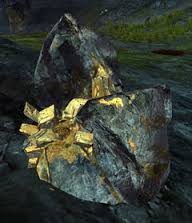
But Frost’s doubts about such approaches to poetic composition take a surprising form. From the premise that “the object in writing poetry is to make all poems sound as different as possible from each other” he argues that a reliance solely on linguistic and formal elements (“that of vowels, consonants, punctuation, syntax, words, sentences, metre”) is never going to be enough to achieve this aim. If we abstract for use only the sonic and formal elements of poetry, “[a]ll that can be done with words is soon told”. Frost is known for his interest in form (as against other Modernists’ scepticism about it) so it’s with some surprise that we hear him say: “So also with metres – particularly in our language where there are virtually but two, strict iambic and loose iambic. The ancients with many [more varieties of metre] were still poor if they depended on metres for all tune. It is painful to watch our sprung-rhythmists straining at the point of omitting one short from a foot for relief from monotony”.
With this Frostian chuckle, it’s clear that only monotony results from this approach and also that the poet can only gain relief from it with “the help of context-meaning-subject matter”. This clumsy, composite term is quickly honed down to the single word “meaning” (later in this essay he uses “theme” and “subject” to refer to the same thing). This is Frost’s argument against the lure of abstraction. The poet – even merely to achieve poems which sound as different as possible from each other – must have something to say, must mean something. The limits of pure sound/form can be breached once meaning is played across the sonic/formal qualities of language. For me this gives rise to images of a jazz soloist improvising across the rhythms of a band. For Frost: “The possibilities for tune from the dramatic tones of meaning struck across the rigidity of a limited metre are endless. And we are back in poetry as merely one more art of having something to say”.
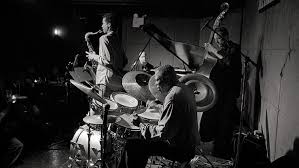
The third paragraph opens: “Then there is this wildness whereof it is spoken”. The quasi-Biblical turn of phrase here suggests irony is again at work and it is a second form of abstraction that Frost is mocking. The “wildness” of a poem is the way its component parts are related – or not – to each other. He mocks the kind of “Poem” – note the ironic upper-case – that results from those who seek “to be wild with nothing to be wild about”. Though the sudden switches of focus, the jump-cuts of strong emotion, the leaps and gulfs of epiphanic moments are certainly (Frost implies) part of great poetry, the Modern(ist) abstractionist will want the leaps and jumps “pure”. Frost is again concerned about the lack of “context-meaning-subject matter” in this kind of poetry. He is taking aim at Surrealism with its reliance on irrational leaps, its dislocation of the senses, the shock value of the illogical. For Frost such practices lead only “to undirected associations and kicking ourselves from one chance suggestion to another in all directions as of a hot afternoon in the life of a grasshopper”. To create poetry that has something to say, Frost suggests for the second time that “Theme alone can steady us down [. . .] a subject that shall be fulfilled”.
Paragraphs 4–6
The essay now moves away from the constituents of a poem to the process of its writing, a process Frost sees as organic, instinctive, unpredictable, exploratory, holistic, and – like love – an experience and source of pleasure. This is where he uses the title phrase and the figure of a poem turns out to be ‘the course run’ by the poem, its track or trail or locus. The elliptical sequencing of the next few paragraphs doesn’t help the reader but Frost considers 5 areas: the poem’s origins, its development, its impact on writer and reader, the importance of the poet’s freedom.
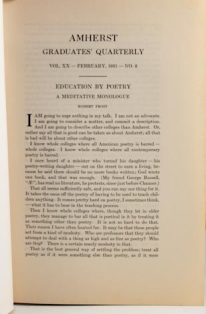
The delight with which a poem begins is “the surprise of remembering something I didn’t know I knew”. I don’t think this need be a literal recalling (on this Frost is not Wordsworth) but an insight or sensing of a connection between things which has a familiarity and feels like a remembrance. (The way in which metaphor is at the root of poetry and, perhaps, all knowledge is a point Frost developed in ‘Education by Poetry’ (1931)). The substance of this initial insight is what constitutes at least the beginnings of the “context-meaning-subject matter” so essential to any successful poem. All poets will recognise such a moment as Frost describes: “I am in a place, in a situation, as if I had materialized from cloud or risen out of the ground. There is a glad recognition of the long lost and the rest follows.” But from such momentary delight and recognition (which will be accompanied by powerful emotions, even tears), Frost makes it clear the process, the figure, of the poem’s making, still lies ahead and is one of surprise and discovery.
As the poem struggles to exist, the poet must remain alert and watchful to what may help build it as “it inclines to the impulse, it assumes direction with the first line laid down, it runs a course of lucky events”. It is a fundamentally metaphorical process of making connections, often quite unforeseen ones: “The impressions most useful to my purpose seem always those I was unaware of and so made no note of at the time”. In a striking image, Frost suggests we are like giants, drawing on elements of previous experience and hurling them ahead of us as a way of paving a pathway into our own future. We make sense of what we encounter by reference to what we have experienced in the past. It’s in this way that a poem is able to result in “a clarification of life – not necessarily a great clarification, such as [religious] sects and cults are founded on, but in a momentary stay against confusion.” Our pathway ahead is illuminated, even if only briefly, by the ordering and landscaping the poem creates towards future experience by reference to what we already know.
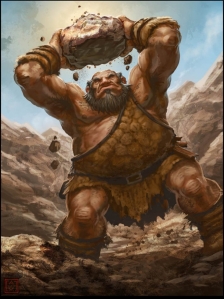
This is why Frost teasingly argues the logic of a good poem is “backward, in retrospect”. What it must not be (and he has his earlier abstractionist targets in mind again) is pre-conceived or imposed before the fact (even if what we pre-impose is the illogical kicking ourselves from one chance suggestion to another). Such willed pre-conception can never yield anything other than a “trick poem”. It is not a prophecy, but rather something “felt”, a feeling figure, an emotional response involving both past and future and it must be “a revelation, or a series of revelations, as much for the poet as for the reader.” The crucial role of emotion is perhaps easily missed. And to allow the role of the passions, Frost insists on the greatest freedom of the poetic materials to move about, to be moved about, to establish relations regardless of time and space, previous relation, and everything but affective affinity. This is Frost’s answer to one of the writer’s constant quandaries: how true to the original experience must I be? For Frost, truth to the emotional response at the inception of the poem (not necessarily the original incident’s emotional charge) is key and that demands artistic independence and freedom. Some distance is required.
Paragraph 7
The essay comes to concentrate finally on the necessary freedoms of the poet. The artist’s freedom is the freedom to raid his own experiences: “All I would keep for myself is the freedom of my material – the condition of body and mind now and then to summons aptly from the vast chaos of all I have lived through.” It’s in this freedom that Frost contrasts scholars/academics and artists. Scholars work from knowledge. But so do artists – this is the point of the early paragraphs of the essay. But the two groups come by their knowledge in quite different ways. Scholars get theirs via a conscientious and thorough-going linearity of purpose. Poets, on the other hand, acquire theirs cavalierly and just as it happens, whether in or out of books. Poets ought to “stick to nothing deliberately, but let what will stick to them like burrs where they walk in the fields”. Poets do not learn by assignment, Frost says, not even by self-assignment.
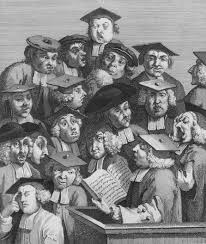
In the course of the figure a new poem may be making, the poet must assert his liberty to work in a dramatically metaphorical way, to be possessed of both “originality” and “initiative” in order to be able to snatch “a thing from some previous order in time and space into a new order with not so much as a ligature clinging to it of the old place where it was organic”.
Frost concludes with another vivid image of the poem making its figure in the course of composition. “Like a piece of ice on a hot stove the poem must ride on its own melting.” The aptness of the image lies partly in the ice’s gradual vanishing (what a poem can offer is only ever “momentary”) and the frictionless quality reflects Frost’s insistence that a poem cannot be “worried into being” through pre-conceived effortfulness. The ice’s movement is generated and facilitated by its own process of melting and the poem too must propel itself (not be propelled by the artist). The resulting figure follows an unpredictable and fresh course, the links it draws from both past and present towards the future offering temporary clarifications of all three for the poet and (something Frost does not explore here) perhaps finally broadcast, available and effective for its readers too.

Dear Martyn,
A wonderful untangling of Frost’s sometimes gnomic instruction, thank you.
Robert Pinsky teaches his class to take a word for a title, then to brainstorm words that come to mind and group them by sound and looking it over, try to connect the words in odd ways. The goal is to get in touch with the elusive unconscious, so a little like play. Surprise and delight.
I’ve interpreted that piece of ice on a hot stove riding on its own melting to indicate that the form of a poem enacts its own dynamic, its own content. Many modern poems express wildness by wildness of structure, a little like modern architecture: sometimes too wild, too willed.
cheers,
bert
LikeLike
Thanks Bert – yes, gnomic is about right. The cryptic wisdom of the New England farmer – or the type Frost liked to play at.
LikeLike
Thanks very much for this excellent piece.
LikeLike
[…] recently posted a discussion about Robert Frost’s brief essay ‘The Figure a Poem Makes’. In this post I’m looking at one of the poems I’ll be teaching next year from the Cambridge […]
LikeLike
[…] have recently posted about Robert Frost’s brief essay ‘The Figure a Poem Makes’ as well as on one of his lesser known poems, ‘A Soldier’. The latter is one of the poems I’ll […]
LikeLike
[…] Auden refers us to Virgil’s Eclogues, and poets like Campion, Herrick and Mallarme (I’d add other assorted Surrealists, Dylan Thomas, John Ashbery). In being turned away from historical reality, there is inevitably a […]
LikeLike
[…] earlier post in which I talked my way through Frost’s essay ‘The Figure a Poem Makes’ has proved to be one of my most visited pieces. As both teacher and poet, I wanted to explore […]
LikeLike
[…] “When I looked at this poem again today, I remembered and revisited a brilliant summary of Robert Frost’s essay The Figure a Poem Makes, by Martyn Crucefix available to read on Martyn’s website, here. […]
LikeLike